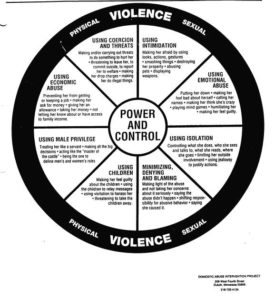DEFINITION OF DOMESTIC VIOLENCE
Domestic violence is a pattern of assaultive and coercive behaviors, including physical, sexual, and psychological attacks, as well as economic coercion, that adults or adolescents use against their intimate partner.
DOMESTIC VIOLENCE IS:
- A pattern of behaviors including a variety of tactics – some physically injurious and some not, some criminal and some not – carried out in multiple, sometimes daily episodes.
- A pattern of assaultive and coercive behaviors, including physical, sexual, and psychological attacks, as well as economic coercion.
- A combination of physical force and terror used by the perpetrator that causes physical and psychological harm to the victim and children.
- A pattern of purposeful behavior, directed at achieving compliance from or control over the victim.
- Behaviors perpetrated by adults or adolescents against their intimate partner in current or former dating, married or cohabiting relationships of heterosexuals, gays and lesbians.
Prepared by Anne L. Ganley, Ph.D. for the Family Violence Prevention Fund
DOMESTIC VIOLENCE STATISTICS
- One out of every three women will be abused at some point in her life.
- Battering is the single major cause of injury to women, exceeding rapes, muggings
and auto accidents combined. - A woman is more likely to be killed by a male partner (or former partner) than any other person.
- About 4,000 women die each year due to domestic violence.
- Of the total domestic violence homicides, about 75% of the victims were killed as they attempted to leave the relationship or after the relationship had ended.
- Seventy-three percent of male abusers were abused as children.
- Thirty percent of Americans say they know a woman who has been physically abused by her husband in the past year.
- Women of all races are equally vulnerable to violence by an intimate partner.
- On average, more than three women are murdered by their husbands or partners in this country every day.
- Intimate partner violence a crime that largely affects women. In 1999, women accounted for 85% of the victims of intimate partner violence.
- On average, a woman will leave an abusive relationship seven times before she leaves for good.
- Approximately 75% of women who are killed by their batterers are murdered when they attempt to leave or after they have left an abusive relationship.
FREQUENTLY ASKED QUESTIONS ABOUT DOMESTIC VIOLENCE
Do women who stay in abusive relationships like the abuse?
No one wants to be hurt, beaten or made to feel inferior. Women stay in abusive relationships for a number of reasons. Women may have nowhere to go. They may believe that it is better for their children to stay in a stable home. For many women, the reason they stay is because of fear. Statistics show that 75% of women who are murdered by their batterers are killed when they leave or after they leave the relationship.
Why do people become batterers?
There is no single reason for abuse. Violence is a means of trying to exercise power and control over someone else. Many batterers were victims of abuse as children or came from families in which spousal abuse was prevalent. It is important to remember, however, that not all people who were victims of abuse as children will turn into batterers.
Can you identify a potential batterer when you meet him/her?
Just as there is not one reason for abuse, there is not one type of batterer. Many batterers are highly successful professionally and in other areas of their lives. With history and society to support their beliefs, they may have little remorse or regret over battering.
Are victims of domestic violence weak people?
The fact that people experience domestic violence doesn’t make them inherently weak. Through manipulation and coercion abusers often chip away at the victim’s self-esteem. Sometimes this process happens so subtly that the victim is unaware of the psychological, emotional and other types of abuse that often precede a physically violent attack. In addition, it is important to note that many victims grew up in homes where there was excessive violence and turbulence. They may have seen their parents abuse alcohol and drugs, and consequently blamed themselves for the dysfunction and unhappiness.
What do abused women want and need?
The first thing that an abused woman needs is to be safe. If she is in danger it is very difficult to think beyond the immediate crisis. She does not need someone to tell her to snap out of it or to insult her for being in her position. Basically, a victim needs support, someone who will listen to her, and she needs information about services. Above all, she needs respect.
Is it true that most violent relationships go through cycles – from tension building to an active battering incident, leading to the honeymoon or ?remorseful? stage?
This pattern, called the Cycle of Violence, came from the battered women’s movement in the 1970?s. The idea has changed over the years because many women found that their relationships did not go through these phases. For some people there is no honeymoon phase. Others do not see the tension building. Women’s rights activists today have changed the model, renaming it the Campaign of Violence.The new name suggests that the violence is ongoing and multi-faceted, taking a variety of forms.
Are men violent because they lose control?
No. Domestic violence is not a form of losing control; it is an attempt at gaining control. Most acts of violence are premeditated, occurring behind closed doors. It may seem as though the batterer is losing control because of his angry behavior. To that end, most batterers are very good manipulators. They know how to convince others and their victims that they are not at fault for their actions.
Do drugs and alcohol cause domestic violence?
The need to exercise power and control is the cause of domestic violence. Drugs and alcohol enable people to lose their inhibitions, and cloud sound judgment. As a result, violence may be exacerbated by the use of these substances. It is important to remember, however, that it is not the cause.
What can I do if I, or someone I know is being abused?
There are many options available to people who need help. You can look in the local phone book or in a community services directory for the phone number of a shelter and counseling services closest to you. You can talk to someone you trust, or call any 24-hour hotline. The number for the state hotline is 1-800-500-1119. In the Florida Keys you can reach the Domestic Abuse Shelter, Inc. (DAS) 24 hours a day, seven days a week at (305) 743-4440.
WHY WOMEN STAY
A question often asked by society is: Why don’t battered women leave their abusers? According to Michael Down, Director of the Battered Women’s Justice Center at Pace University School of Law, asking this question suggests that battered women can control the violence. It also suggests, in a subtle way, that the women are to blame when they are unable to leave abusive partners. Victims cannot control this violence; the ones responsible are the abusers.
There are a number of reasons why women stay. The reasons are usually very compelling. Women who do walk away usually accomplish this through the assistance and support of friends, family, and the legal and medical community. For those who choose to stay, the reasons vary.
- Fear: Fear of the unknown. Sometimes leaving the abuse and being alone will be more frightening for the victim than remaining in the relationship. Also, the abuser usually tends to threaten the victim and the children with physical harm if they try to leave. Statistics show that women who leave their batterers are at a 75% greater risk of being killed by the batterer than those who stay.
- Children: Being a single parent may be a terrifying experience for a battered woman. The responsibility of raising children alone can be too much to bear (even if the spouse/boyfriend has never assisted in the care taking needs of the children.) The abuser will often use the children as a pawn against the victim by threatening to take them away if the woman attempts to leave.
- Promises of Reform: The abuser will frequently promise that it will never happen again; the victim wants to believe that this is true.
- Guilt: The woman may believe that her husband is sick and needs her help. Women are trained to think that they can save their abusive mates, that they can change. Thus, the idea of leaving her spouse can produce feelings of guilt.
- Lack of Self-esteem: The woman may come to believe that she somehow deserves the abuse to which she has been subjected (she has been told this repeatedly by her partner). Lack of self-esteem and the belief that she doesn’t deserve anything better can be paralyzing for a battered woman. This lack of self-esteem cuts across racial, ethnic, religious and socioeconomic lines. Physicians, attorneys, judges, and professors can be, and are, battered.
- Love: Most people enter a relationship for love, and that emotion does not simply disappear in abusive relationships. Most women want the violence to end, but love their partner and want the relationship. According to G.L. Bundow, a South Carolina physician, I know that when I took my marriage vows, I meant for better or for worse. This physician accepted the abuse, and it wasn’t until the day that the until death do us part section of her wedding vows became a frightening reality that she was motivated to leave the relationship.
- Sex-role Conditioning: Women are still taught to be passive and dependent upon men. In addition, women generally accept the responsibility for the state of their relationships; to leave is to admit failure.
- Societal Acceptance/Reinforcement of Marital Violence: Many people believe that marital violence is acceptable. She’s there because she likes it, or a little slap will keep her in line.
- Economic Dependence: The economic reality for women (particularly with children) is a bleak one, especially for women who have not worked outside the home. Economic dependency on the spouse is often a very real reason for remaining in the relationship. She may not have (or know of) any other resources.
- Religious Beliefs: Often, religious beliefs reinforce God’s plan, may be a powerful reason for staying.
- Cultural or Ethnic Background: Often a person’s cultural or ethnic background may discourage revealing the fact that the person is a victim of domestic violence. As a result, the victim will remain in the relationship in order to avoid persons outside the family from finding out.
- Stigma of a Broken Home: Society considers that families who separate are broken. This implies that something is wrong with such a family, even though the intact family environment may be a violent and dangerous one.
- Satisfaction with the Relationship between Incidents of Battering: The abusers are often very charming and loving when not abusing the victim. The women often tend to fall for their batterer’s softer side, especially the tenderness that they show immediately following each attack.
THE ABUSED VICTIM: REASONS FOR NOT SEEKING HELP
There are many complex reasons for not seeking help from domestic violence. The reasons vary from individual on why they do not reach out. The following are some common reasons why she/he may not reach out:
- Things aren’t so bad
- Fear
- Abuse of a child
- Questioning relationship
- Fear of the unknown is less than fear in the relationship
- Fear of death
- Wanting to talk to someone, seeking support
- Willing to break the secret
- Act of violence/police intervention
- Acceptance of situation/admitting there is
DOMESTIC VIOLENCE AWARENESS QUIZ
- Domestic violence affects only a small percentage of the population.
- TRUE
- FALSE
- Domestic violence occurs mostly in lower socioeconomic groups.
- TRUE
- FALSE
- Women are most often the victims rather than the perpetrators of abuse.
- TRUE
- FALSE
- Children who are abused often become abusers themselves.
- TRUE
- FALSE
- Alcohol and other drug abuse cause violent behavior.
- TRUE
- FALSE
- It’s easy to identify a batterer based on how he behaves in public.
- TRUE
- FALSE
- Abuse does not stop and may even intensify when the woman is pregnant.
- TRUE
- FALSE
- Children living in homes where domestic violence is present probably aren’t affected emotionally unless the violence is targeted at them.
- TRUE
- FALSE
ANSWERS TO QUIZ
- False. Domestic and sexual violence affect a large percentage of the population, cutting across all racial, ethnic and socioeconomic boundaries. According to statistics one in three women is a victim of domestic violence. One in three girls and one in six boys are victims of sexual abuse before they reach the age of 18.
- False. Domestic violence occurs at all socioeconomic levels. Financial pressures may put pressure on families that can exacerbate violence, but it is important to remember that socioeconomic pressures are NOT the cause. Domestic violence is a result of the need for one person to exercise power and control over another. The problem is prevalent in upper, middle and lower class communities alike.
- True. Intimate partner violence a crime that largely affects women. In 1999, women accounted for 85% of the victims of intimate partner violence.
- False. While approximately seventy-three percent of abusers were victims of violence as children, not all victims turn into batterers. Many victims grow up to be loving, healthy parents.
- False. Although alcohol and/or drugs are present in almost 50% of abuse cases, they are never the cause of violence. An insatiable need for power and control is the cause for domestic violence. Alcohol and drugs may loosen inhibitions allowing batterers to unleash violent behaviors.
- False. It is often very difficult to identify a batterer. Domestic violence is one of the most clandestine problems. Batterers are often skillful manipulators, knowing how to present a good image so that the violence remains a secret. Many people are surprised when they learn that their neighbor, friend or family member is a batterer.
- True. According to statistics, women are at greater risk of being victimized by domestic abuse when they are pregnant. Batterers may feel increasingly threatened and jealous of the victim’s attention towards the unborn baby, and become more violent as a result.
INTERNATIONAL STATISTICS ON VIOLENCE AGAINST WOMEN
In February 1993, the United Nations General Assembly adopted the Declaration on the Elimination of Violence against Women. The document defines violence against women as any act of gender-based violence that results in, or is likely to result in, physical, sexual or mental harm or suffering to women, including threats of such acts, coercion or arbitrary deprivation of liberty, whether occurring in public or private life.?
Violence against women is a problem in every country in the world. The statistics are staggering:
- In every country where reliable, large-scale studies have been conducted, results indicate that between 10% and 50% of women report they have been physically abused by an intimate partner in their lifetime. (WHO, 2000)
- Population-based studies report between 12% and 25% of women globally have experienced attempted or completed forced sex by an intimate partner or ex-partner at some time in their lives. (WHO, 2000)
- Interpersonal violence was the tenth leading cause of death for women around the world 15 – 44 years of age in 1998. (WHO, 2000)
- Forced prostitution, trafficking for sex and sex tourism appear to be growing. Existing data and statistical sources on trafficking of women and children estimated 500,000 women entering the European Union in 1995. (WHO, 2000)
- Among women aged 15 – 44 worldwide, gender-based violence accounts for more death and ill health than cancer, traffic injuries and malaria put together. (World Bank, 1993)
- Approximately 60 million women, mostly in Asia, are ?missing? killed by infanticide, selective abortion, deliberate under-nutrition or lack of access to health care. (Panos 1998: UNFPA)
- Based on recent studies, more than 130 million girls and women, mostly in Africa, have undergone female genital mutilation, and an estimated 2 million girls are at risk for undergoing the procedure each year. (WHO, 1998)
- In 9 Latin American countries, a rapist who marries his victim stays out of jail. (Chiarotti, 2000)
- Studies suggest that one-fourth to one-third of the 170 million women and girls currently living in the European Union are subjected to male violence. (Logar, 2000)
COUNSELING STRATEGIES WITH VICTIMS OF DOMESTIC VIOLENCE
- Ask about the violence and the emotional coercion.
- Support her telling her story again and again. Acknowledge the courage in telling.
- Find her strengths and point them out to her.
- Build upon her hopes, dreams, and plans for the future.
- Rebuild her social-support network or create an alternative network that is trustworthy.
- Stick with her, even when you get frustrated.
- Build her knowledge of options and advocate for her.
- Provide concrete assistance.
- Take an active concern and help her plan for her safety.
- Respect her choices. Only she lives with the consequences. Let her maintain control.
- Collaborate with other services that can help her. Work actively with them.
Family Violence Prevention Fund
The Domestic Abuse Shelter offers
free and confidential services that are tailored to the needs of each survivor.
Please contact our 24 Hour Hotline to speak with
an advocate: (305) 743-4440


